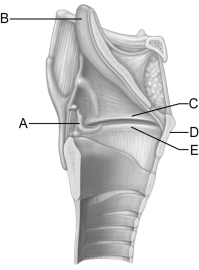A) tuberculosis.
B) emphysema.
C) bronchitis.
D) pneumonia.
Correct Answer

verified
Correct Answer
verified
Multiple Choice
A chronic respiratory disease that leads to an expanded "barrel chest" is
A) emphysema.
B) lung cancer.
C) tuberculosis.
D) pneumonia.
Correct Answer

verified
Correct Answer
verified
Multiple Choice
Which structure does not enter or exit from the hilum of a lung?
A) bronchial vein
B) phrenic nerve
C) pulmonary artery
D) pulmonary plexus
Correct Answer

verified
Correct Answer
verified
Multiple Choice
The correct definition of bronchopulmonary segments is
A) arbitrary subdivisions of a lung, about as large as a fist (0.3 liter) .
B) parts of the lung that are easy to remove during surgery.
C) parts of the lungs that are separated by the oblique and horizontal fissures.
D) parts of the lung that are supplied by a single tertiary bronchus (and its branches) .
Correct Answer

verified
Correct Answer
verified
Short Answer
The ________ marks the point where the trachea branches into the two main bronchi.
Correct Answer

verified
Correct Answer
verified
True/False
Gas exchange occurs across the bronchi and bronchioles.
Correct Answer

verified
Correct Answer
verified
Short Answer
The ________ tonsil, or adenoids, is located on the wall of the nasopharynx.
Correct Answer

verified
Correct Answer
verified
True/False
The pleural cavities extend two ribs below the inferior border of the lungs.
Correct Answer

verified
Correct Answer
verified
Multiple Choice
The part of the brain that generates the basic respiratory rhythm is the
A) medulla oblongata.
B) limbic system.
C) hypothalamus.
D) cerebrum.
Correct Answer

verified
Correct Answer
verified
Multiple Choice
 Figure 22.3
Use the diagram above to answer the following questions.
-Identify the letter that indicates the cartilage that anchors the vocal cords posteriorly.
Figure 22.3
Use the diagram above to answer the following questions.
-Identify the letter that indicates the cartilage that anchors the vocal cords posteriorly.
A) A
B) B
C) C
D) D
E) E
Correct Answer

verified
Correct Answer
verified
Essay
Describe the effects of smoking on (a) alveolar structure, (b) cilia and alveolar macrophages, and (c) the bronchial epithelium.
Correct Answer

verified
Components of tobacco smoke lead to dest...View Answer
Show Answer
Correct Answer
verified
View Answer
Short Answer
The function of type II alveolar cells is to produce ________.
Correct Answer

verified
Correct Answer
verified
Multiple Choice
What type of epithelium occurs in the respiratory mucosa?
A) pseudostratified ciliated columnar epithelium
B) simple squamous epithelium
C) simple columnar epithelium
D) stratified squamous epithelium
Correct Answer

verified
Correct Answer
verified
Multiple Choice
Anatomical region of the nasal cavity containing nose hairs.
A) nasal septum
B) olfactory mucosa
C) nasal conchae
D) vestibule
E) uvula
Correct Answer

verified
Correct Answer
verified
True/False
Type II alveolar cells produce pleural fluid to keep the walls of the alveoli from collapsing or adhering together.
Correct Answer

verified
Correct Answer
verified
True/False
The groove through which air passes between nasal conchae is called a choanae.
Correct Answer

verified
Correct Answer
verified
Multiple Choice
Which pulmonary disease is characterized by a permanent enlargement of the alveoli?
A) emphysema
B) tuberculosis
C) pneumonia
D) lung cancer
Correct Answer

verified
Correct Answer
verified
True/False
The scalene muscles are involved in deep inspiration.
Correct Answer

verified
Correct Answer
verified
Multiple Choice
In a preserved cadaver, the first rib is likely to form a groove on which surface of the lung?
A) basal
B) mediastinal
C) inferior costal
D) apical (apex)
Correct Answer

verified
Correct Answer
verified
Multiple Choice
Which muscle contracts during forced expiration?
A) internal oblique
B) serratus anterior
C) sternocleidomastoid
D) pectoralis major
Correct Answer

verified
Correct Answer
verified
Showing 21 - 40 of 110
Related Exams